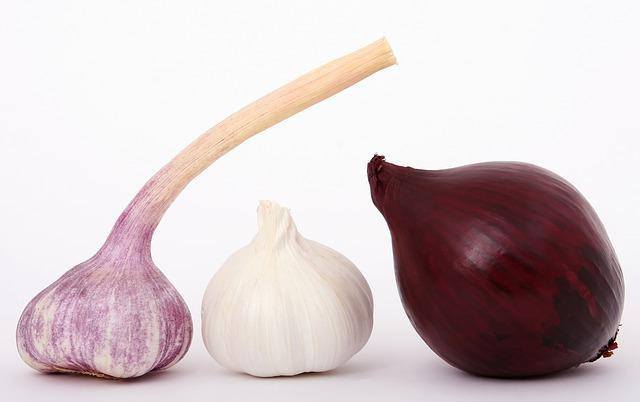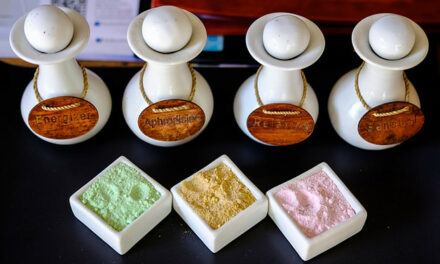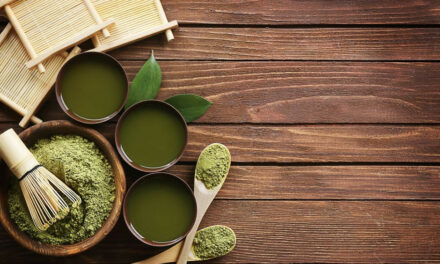When buying garlic, should I go for purple garlic or white garlic? What’s the difference between Purple Garlic Health Benefits from white garlic? What are other differences between Purple Garlic vs. White Garlic? Some of the many questions you might be asking about these two types of garlic.
Your questions are very valid as the differences between the two are quite significant.
Before exploring the differences, let’s touch up on the garlic… What is it?
What is Garlic?
Garlic is one of the most common and popular eaten ingredients. In every household kitchen, you can easily find garlic. In some places today, people have the habit of regularly eating garlic every day.
There are many types of garlic, like purple, regular, white, and black garlic, and all of them have different properties.
Garlic, in general, has many vitamins and minerals, including manganese, vitamin C, selenium, vitamin B6, etc.
Some say eating garlic is essential if you have diabetes, primarily type 2 diabetes, blood pressure, and other chronic diseases. Garlic has been an immune and overall health booster for centuries.
Several studies suggest that consuming a moderate amount of garlic is suitable for people with type 2 diabetes. Hence, it can regulate your blood sugar levels and improve insulin sensitivity.
Apart from that, it can also keep your heart healthier by reducing your blood pressure. But health benefits aside, you should consider other things if you’re planning to increase your garlic intake.
As I said below, the intention of this article is to dig deeper into the claims about the effects of garlic on the health of purple garlic compared to white ones.
Particularly, this article is a must-read for you if you have type 2 diabetes or any other chronic disease and are still interested in consuming some purple or white garlic. In short, we will discuss purple garlic and white garlic, their differences and health benefits etc., here.
What is Purple Garlic?
Have you ever seen garlic with purple skin? Purple garlic is not the one that has gone bad, but it is a different variety of garlic.
It has a purple-streaked hue, and underneath this purple skin, it is white.
The other name of purple garlic is purple stripe garlic, as it is one of the hard neck varieties of garlic that has purple stripes on the outer skin.
Most importantly, the coveted purple garlic is best to use. However, it is also a good sign that you have some great-tasting garlic cloves. The purple color is only on the outer skin and not the actual cloves of the garlic. Thus, the cloves are the same, but the flavor might surprise you. Moreover, they are also perfectly safe to eat.
Purple garlic is famous and valued in national and international markets due to its high quality and intense flavor.
It is the best culinary compliment in today’s cuisine due to its high allicin content and low on the palate and nose. The membranes or outer skins are white with purple garlic. Moreover, the color of the garlic clove is purple. They also have regular thick cloves, but the heads are not as big as other varieties.
|
Size |
Medium |
|
Garlic head |
Round and uniform, white skin, with possible dyes of soft violet tones. |
|
Cloves |
Intense/violet color, with a slightly curved shape and shiny skin. |
|
Number of cloves/garlic head |
8 – 10 cloves. |
|
Aroma |
Intense with high allicin content. |
|
Taste |
Intense/spicy |
Properties of Purple Garlic
In purple garlic, there is Allicin, which has antioxidant and hypoglycemic properties. Hence, these components have a positive impact on our body ́s health.
The antioxidant power reduces free radicals in our bodies and helps prevent cancer. Similarly, the hypoglycemic properties can help lower sugar levels in our bodies.
Additionally, garlic can also help maintain weight as it has a low-calorie count.
What is Regular Garlic or White Garlic?
Regular garlic or white garlic is what you mostly see in grocery stores.
The white garlic comes from a variety that is soft neck garlic. It means that the stalk will not grow through the center of the bulb.
One garlic bulb has its cloves. However, all the cloves are of different sizes and shapes. It includes the larger cloves outside, and the smaller ones can find in the middle.
Mostly, braided together white garlic bulbs are traditionally popular. The primary reason for this is that the stalk at the stem end of the garlic is soft and flexible.
Moreover, white garlic is relatively easy to grow and has a long life on supermarket shelves. Apart from that, white garlic has a robust garlic flavor when it is fresh.
What Is The Difference In The Content Between Purple Garlic and White Garlic?
The main difference between purple garlic and white garlic is its availability and effect in cooking.
White garlic is more prevalent than purple garlic. Similarly, these are always white and easier to raise. Similarly, white garlic is more conducive to shipping and travelling.
Another essential thing about white garlic is its potent scent and flavor. Moreover, it has more cloves than purple garlic. Purple garlic has a milder taste and odor, but it can retain its sweet aroma even after cooking.
Below is the table that can help you to distinguish between purple and white garlic in more detail:
|
Purple Garlic |
White Garlic | |
|
Bulb Size |
Smaller |
Bigger |
|
Neck Size & stiffness |
Long and hard |
Small |
|
No. of Cloves |
Very few (4-5) |
Too many (10-30) |
|
Clove Skin |
Thick, easy to peel off |
Thin, difficult to peel off |
|
Allicin content |
High |
Low |
|
Anthocyanin |
Present |
No such content |
|
Shelf life |
Lesser |
Longer |
Another vital thing about purple garlic is that it is highly nutritious. However, among all the purple garlic, the best type is the Italian purple garlic. Thus, Italian purple garlic is the most popular because of its long shelf life, early harvest, and mild flavor.
The average size of Italian purple garlic is larger and has a radius of 2.5cm approximately. As we all know, garlic is a rich source of minerals and other nutrients, so below is the table.
The table shows the nutrients, their quantity per unit, and the percentage of the daily requirement of the garlic.
|
Garlic (100g) | % of Daily Requirement | |
|
Energy |
623 KJ |
– |
|
Carbohydrates |
33 g |
– |
|
Fat |
0.5 g |
– |
|
Protein |
6.36 g |
– |
|
Manganese |
1.67 mg |
80% |
|
Vitamin C |
31.2 mg |
38% |
|
Vitamin B6 |
1.23 mg |
95% |
|
Choline |
23.2 mg |
5% |
Generally speaking, the nutrition of purple garlic is better; that is why the price of purple garlic is higher than that of white garlic. Purple garlic contains more anthocyanins, and its regular consumption can increase immunity.
Now, let me explain the reality of purple garlic’s health benefits over the white ones.
Purple Garlic Health Benefits
Sometimes two common questions mostly came into the mind of people. The first one is why my garlic is purple, and the second one is it beneficial for human health?
The purple garlic has a purple hue to its papery skin and provides health benefits. However, it has the best capability to impact a person’s immune system positively.
The following are the three essential health benefits of purple garlic.
1. Fewer calories
One of the most significant advantages of purple garlic is that it has fewer calories. But the most important thing is that it is incredibly nutritious.
The clove of the purple garlic contains selenium, vitamin C, manganese, fiber, vitamin B6, etc. It includes a decent amount of calcium, phosphorous, and potassium.
2. Combat sickness
Purple garlic is the perfect way to combat any sickness. If anybody is suffering from a cold or fever, they should consider consuming purple garlic.
Including purple garlic in your diet is a wise decision as it is a stable source of curing different health issues.
For instance, purple garlic can help in reducing blood pressure and hypertension.
3. Improves digestive system
Another great benefit of purple garlic is improving the overall digestive system.
Consuming regular purple garlic can help in reducing the risk of acidity. In addition, it can also cure some other types of stomach aches, etc.
Tip – We already covered Garlic Pills and Supplements.
What Are The Difference Between Purple Garlic Health Benefits Compared To White Garlic?
Both purple and white garlic has various medicinal benefits as they have antioxidants and immune-system boosting components. Below are the 3 main differences in purple garlic’s health benefits compared to white garlic.
1. Juicier cloves
There is no doubt that purple garlic cloves are much juicier than white garlic. Hence, the juicier cloves of purple garlic give an outstanding taste to the people.
It also provides people with a milder and fantastic flavor compared to white.
2. Healthy
Purple garlic has more beneficial compounds than white garlic, so it is much healthier for people to consume.
It is an excellent source of copper, selenium, iron, B6, manganese, vitamin C, etc. If a person consumes purple garlic regularly, it can reduce the risk of two types of diabetes, type 1 and 2, and increase insulin secretion.
3. Shield against the diseases
If you consume purple garlic instead of white garlic, you can have various health benefits. Purple garlic can help a person in getting rid of most early-stage chronic diseases that can cause significant health problems later on.
Similarly, it can act as a shield against various diseases. In simple words, purple garlic is the best as it can prevent people from chronic diseases.
Is Purple Garlic Safe To Eat With Diabetes?
Diabetes is a primary concern all over the world. According to one study, in 2030, it will become the seventh-largest killer in the world.
Diabetes can lead to obesity, heart problems, kidney failure, etc.
Purple garlic is safe to eat if you have diabetes. However, regular consumption of purple garlic reduces the risk of type 2 diabetes. Besides this, it also helps in insulin synthesis.
The best thing about garlic is that it contains sulfur compounds. Thus, this compound reduces the risk of diabetes and also lowers the blood sugar level.
Moreover, in people with diabetes, garlic can also lower blood pressure and triglycerides.
The vitamin C present in purple garlic also plays a significant role in maintaining blood sugar levels.
The following are some significant points that show how garlic is effective for diabetes.
- Garlic is rich in zinc and natural antioxidants, so it can help reduce sugar levels in the blood.
- Amino acid homocysteine is a compound that is a risk factor for diabetes. Prolonged consumption of garlic lowers this compound in the body.
- Allicin found in garlic can increase the level of blood insulin.
- Vitamin B6 regulates the metabolism of carbohydrates, and it is visible in garlic consumption in diabetes patients.
Tip – We explained how Garlic Salt may affect your health already.
Is Purple Garlic Safe To Eat With High Blood Pressure?
Yes, purple garlic is safe to eat with high blood pressure.
Most people suffer from cardiovascular diseases like heart attacks and strokes. Hence, all of them are the biggest killers in the world. One of the most important drivers of these diseases is high blood pressure or hypertension.
The consumption of purple garlic can reduce the risk of high blood pressure. Some active compounds are present in purple garlic that lowers high blood pressure.
When Should You Not Eat Purple Garlic?
Natural purple garlic is perfectly safe to eat, but there are some conditions in which you should not eat purple garlic.
For instance, if your garlic is turning to yellow color, smells foul, or loses its pungent, sharp smell.
Similarly, brown spots on the cloves mean that it is not safe to eat. You should not eat purple garlic if you have allergic to purple garlic varieties.
Additionally, too much purple garlic consumption can also have adverse effects. They can irritate the digestive system and also cause an unpleasant body odor.
Similarly, it can also lead to the development of bad breath and affect blood coagulation. Thus, making it thinner and causing wounds to last longer.
Conclusion
Garlic is one of the most popular vegetables or herbs worldwide. However, white and purple garlic have medicinal benefits and are safe to eat.
Mostly you can find white garlic in the grocery stores. But one can use purple garlic just like white garlic since it has a slightly milder flavor and great taste.
The size of the purple garlic is smaller than the white one as it has fewer cloves.
Most importantly, white and purple garlic have antioxidants and immune-system boosting components.
Purple garlic is safe to eat as it helps lower cholesterol and high blood pressure, and it is also suitable for people who have diabetes.













